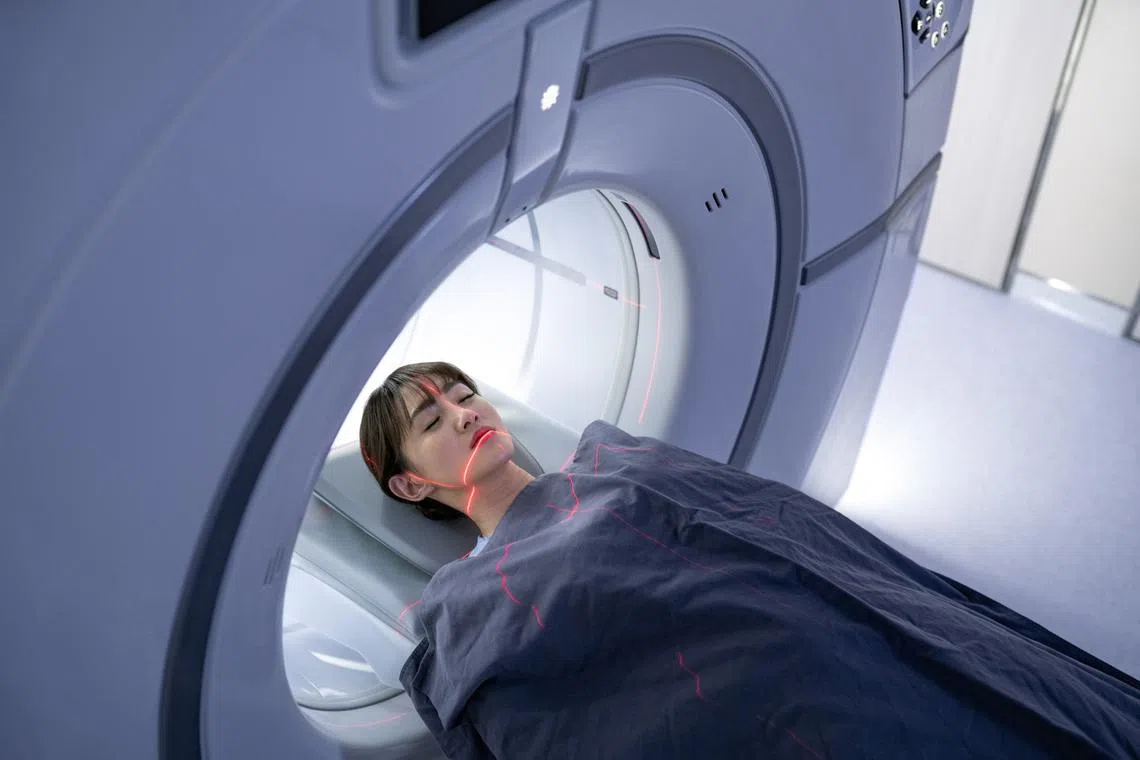BRANDED CONTENT
Unbearable throbbing pain, recurring nausea, light sensitivity: When to seek help for severe headaches and migraine
Different types of headaches need different treatments – and Mount Elizabeth Hospital’s neuro specialists stress the importance of proper check-ups to catch any hidden health issues

Bad headaches, like severe migraines, can be caused by lifestyle factors or underlying medical conditions.
PHOTO: GETTY IMAGES
Follow topic:
What began as occasional mild headaches in 2018 became a painful, daily torment for Mr Alan Senejani. These left him confined to his bed, as he was extremely sensitive to light and sound.
Recalls the 36-year-old: “The pain would reach a 10 out of 10, characterised by an intense, almost unbearable sensation, as though my brain was under extreme pressure. The amount of pain at that moment would be out of this world.”
The severe nausea and vomiting that accompanied these recurrent episodes forced him to frequently abandon work and family outings, so he could retreat to a dark, quiet room for relief.
It was only last October that he was finally diagnosed with a type of migraine consultant neurologist and headache specialist from Mount Elizabeth Hospital (MEH), Dr Zhao Yi Jing
She adds: “Common symptoms associated with these migraines include sensitivity to light and sound, as well as headaches that worsen with movement.”
Migraines like Mr Senejani’s are what doctors call primary headaches, often caused by lifestyle factors. Another common example is the tension headache
However, headaches MEH’s neurosurgeon Dr Ng Zhi Xu
“Some of these medical conditions are dangerous and potentially life-threatening,” he adds.
How do you know when a headache is serious?
Dr Zhi Xu recalls his patient, Ms Kong Suet May, who developed what she described as “the worst headache of her life”. The pain was so intense she could barely speak. The crippling headache, coupled with severe bouts of vomiting, drove her to seek emergency care.
Tests revealed that she had a ruptured intracerebral – or brain – aneurysm thunderclap headache
“The brain receives about 20 per cent of our heart’s blood flow through many blood vessels. When these vessels weaken, they can bulge and form brain aneurysms, which have a risk of bleeding and can lead to severe and life-threatening headaches,” Dr Zhi Xu explains.
Other symptoms, he adds, can include severe nausea and dizziness.

Brain imaging scans, like MRI, help doctors detect serious conditions like aneurysms and tumours that could be the reason for persistent and painful headaches.
PHOTO: GETTY IMAGES
Other underlying conditions that can also cause secondary headaches include brain tumours
Even for primary headaches such as migraines, Dr Zhao explains, the pain experienced can be so debilitating that it significantly impacts daily life, as seen in the case of Mr Senejani.
With 8.2 per cent of the population in Singapore suffering from it, and possibly even more undiagnosed, she emphasises patients to seek help for such symptoms early. This ensures more sinister causes are ruled out and appropriate treatment can be administered.
“It is essential for sufferers to realise that they do not have to endure their pain in silence,” she adds.
Treatments for severe headaches
Getting the right treatment starts with identifying the cause of the headache. This requires thorough evaluations, including physical examinations and, when necessary, brain imaging scans.
These help doctors make accurate diagnoses – such as recognising whether the headache is primary or secondary – and designing appropriate treatment plans, says Dr Ivan Ng, associate professor and senior consultant neurosurgeon at Mount Elizabeth Novena Hospital (MENH)
For secondary headaches caused by conditions like brain aneurysms, surgical intervention may be necessary, he explains. Today’s brain surgeries combine advancements in imaging tools and monitoring systems to help surgeons operate safely and effectively.
For certain brain tumours, he adds, doctors can even avoid traditional surgery with high-energy radiation beams such as proton therapy – similar to targeted X-rays – to destroy tumour cells without making any incisions.
Dr Zhi Xu further notes: “These technologies, often used in combination, can support complex surgeries and reduce potential risks to the patient.”
To treat Ms Kong’s aneurysm, he performed a craniotomy, removing a small piece of her skull to access the burst blood vessel. He then secured the weakened vessel with a tiny metal clip, both stopping the bleeding and preventing future ruptures.
She has made a good recovery, though some effects remain – limited vision in her left eye and fatigue when reading.
Explains Dr Zhi Xu: “These are typical effects patients may experience as part of the healing process after aneurysm surgery.”
For primary headaches like Mr Senejani’s migraines, treatment focuses on long-term management. Dr Zhao initiated a type of migraine treatment delivered through intravenous drips to reduce the frequency and severity of his headaches.
“As a result, he has experienced significant relief from the most distressing symptoms associated with his migraines, particularly the nausea and vomiting,” says Dr Zhao.

As dehydration is a common trigger for tension headaches, it is important to drink adequate water throughout the day.
PHOTO: GETTY IMAGES
While medication plays an important role, Dr Zhao emphasises that managing severe headaches requires a holistic approach, particularly addressing individual triggers that can set off an attack.
For Mr Senejani, this meant tackling multiple triggers – from irregular sleep and skipped meals to frequent work stress. His new routine now includes regular sleep patterns, a daily 30-minute walk, scheduled meals and snacks, and staying hydrated by drinking two litres of water every day.
Moreover, he stopped his intake of alcohol, as well as coffee and chocolate, due to their caffeine-triggering effects.
Today, the father-of-two has been headache-free for over a month since he received treatment and made lifestyle adjustments.
He says: “My quality of life has improved. I can enjoy my days with my family, free from the debilitating pain.”
Simple ways to manage your headaches

Regular exercise is one of several lifestyle habits that can help keep headaches under control.
PHOTO: GETTY IMAGES
Most headaches can be managed on your own, says Dr Zhao Yi Jing, consultant neurologist at Mount Elizabeth Hospital. For instance, you can:
Take over-the-counter pain medication
Get seven to eight hours of sleep every day
Stay hydrated by drinking seven to eight cups of water daily
Have regular meals
Schedule short rest periods during work
Exercise regularly
Reduce or eliminate the consumption of caffeine and alcohol
Dr Zhao’s patients have also identified effective home remedies on their own, which include taking cold showers and sleeping in a cool, dark room.
“Every patient is unique, and what may work for one person may not work for another,” she notes. “It helps when you identify personal headache triggers and learn to adapt your lifestyle accordingly.”
For chronic headaches, prescribed medication combined with a healthy lifestyle often provides the most effective long-term management strategy, she adds.
However, Dr Zhao advises seeking immediate medical attention if you experience:
Severe or persistent headaches that are frequent and worsen over time
Headaches with vision changes or confusion
Sudden onset of intense head pain
These could be signs of a more serious, underlying condition. If you are unsure what you could be experiencing, you can decode your headache with this quiz
To learn more about what your headaches and migraine are telling you, visit Mount Elizabeth’s hub of resources


